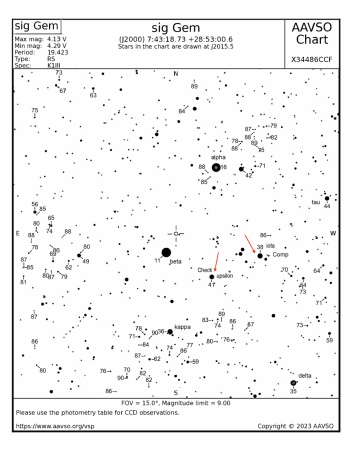October 18, 2023
AAVSO Forum threads (scroll to the bottom of a thread for latest posts):
- Campaigns and Observing Reports: https://www.aavso.org/sigma-gem-campaign
Please subscribe to this thread if you are participating in the campaign so you may be updated by the astronomer and by HQ. Join in the discussion or ask questions there!
Shashank Dholakia (University of Queensland, Brisbane, Australia) requests AAVSO observers' assistance in monitoring the bright RS CVn-type variable sigma Gem in support of satellite-based (TESS) and ground-based observations (CHARA interferometric array).
Dholakia writes: "One of the primary challenges to understanding both stars and the planets orbiting them is being able to map the surfaces of stars. Sigma Gem is a bright (V 4.13-4.29 mag), relatively nearby, highly active red giant with large spots and a rotation period of 19.5 days, which makes it a benchmark star for understanding starspots and how to map them on stars other than the Sun...Sigma Gem will be observed with precision differential photometry by the Transiting Exoplanet Survey Satellite (TESS). This is the perfect opportunity to test the ability of photometry to map the surfaces of stars, which can be subject to significant uncharacterized limitations.
"In particular, Sigma Gem is one of only a handful of stars whose spots can be imaged using interferometry, giving us a ground truth about its surface. We have time with the CHARA optical interferometer to monitor this star at the same time as the TESS observations. We intend to cross compare the interferometric spot maps with those from precision photometry.
"While TESS is a highly precise photometer, it has certain limitations which we intend to resolve with AAVSO observations. Firstly, TESS is a single-color broadband photometer, but we would like to test the possibility that multicolor photometry can map stars more accurately than single-color photometry. Secondly, TESS must stop observing to downlink data around 29th October, Nov 11th and Nov 24th, interrupting an otherwise continuous stream of photometry. Without ground-based observations, we may not be able to stitch together these disjoint light curves."
OBSERVATIONS
TESS is observing sig Gem now through December 7, 2023. AAVSO multicolor photometry (BVRI, with V and I prioritized) is requested beginning immediately through December 15.
Photoelectric Photometry (PEP) observations are the most practical and are requested, because of the brightness of sig Gem and the wide field needed to include the chosen comparison and check stars (see Table below). For PEP observers with JH capability, these observations would be welcome, but the VIBR coverage is more important, so please don't use observing time in switching between photometers.
CCD/CMOS wide angle observations and/or all sky differential photometry is welcomed, as long as the selected comp and check stars fit in the field. Unfiltered observations will be carried out by TESS, so CV or CR observations may be useful in the TESS gaps, but otherwise not.
Re the cadence of time-series and duration of observations, Dholakia writes: "We would like once-per-night observations with multiple filters during all possible dates between now and Dec 7th, and several observations per night for the times surrounding the TESS breaks. We will need high SNR data with high precision, but even more importantly accurate error estimates, since the end goal is to characterize the limitations in mapping stars with photometry." Please continue the nightly observations through December 15 in order to provide good context for the observations made during the satellite coverage.
Sig Gem is currently an early-morning target, and the extra effort of making these observations is very greatly appreciated.
Regarding spectroscopy, he writes: "Spectroscopy could be useful to perform Doppler imaging as another technique to map the star, but since the rotation period is rather slow, it will need a high resolution spectrograph, of R 30,000 or better, and high SNR." If someone has such resources, please contact him directly at <s.dholakia@uq.edu.au>.
Target, comparison, and check stars
| Name | RA(2000) | Dec(2000) | Comment | ||
|---|---|---|---|---|---|
| target | sig Gem | HD 62044 | 07:43:18.73 | +28:53:00.6 | VSX entry for sig Gem |
| comp | iota (iot) Gem | HD 58207 | 07:25:43.60 | +27:47:53.1 | 38 on chart* |
| check | upsilon (ups) Gem | HD 60522 | 07:35:55.35 | +26:53:44.7 | 41 on chart* |
* chart is 'a' scale AAVSO chart for sig Gem; see photometry table for this chart for the BVR mags (I mag is being determined)

The above 'a' scale AAVSO chart shows sig Gem, with the requested comparison and check stars identified.
Charts with comparison stars for sig Gem may be created using the AAVSO Variable Star Plotter (VSP).
Please report observations to the AAVSO International Database using the name SIG GEM.
This Alert Notice was compiled by Elizabeth O. Waagen using information provided by Shashank Dholakia.
----------------------------------------------------
SUBMIT OBSERVATIONS TO THE AAVSO
Information on submitting observations to the AAVSO may be found at:
- Photometry/visual observations: https://www.aavso.org/webobs
- Spectroscopy: https://www.aavso.org/apps/avspec/
ALERT NOTICE ARCHIVE AND SUBSCRIPTION INFORMATION
An Alert Notice archive is available at the following URL:
https://www.aavso.org/aavso-alert-notices-for-observing-campaigns-and-discoveries
Subscribing and Unsubscribing may be done at the following URL:
https://www.aavso.org/aavso-alert-notice-subscribe
----------------------------------------------------------
Please support the AAVSO and its mission -- Join or donate today:
https://www.aavso.org/join-aavso

